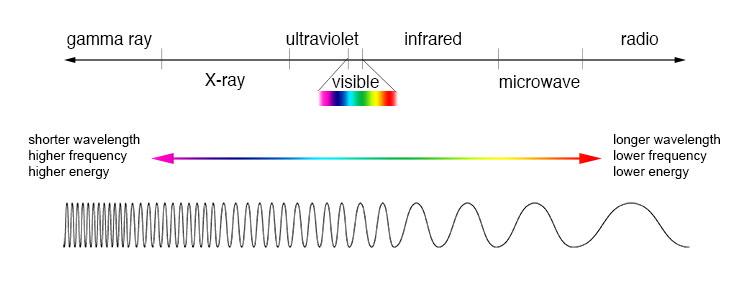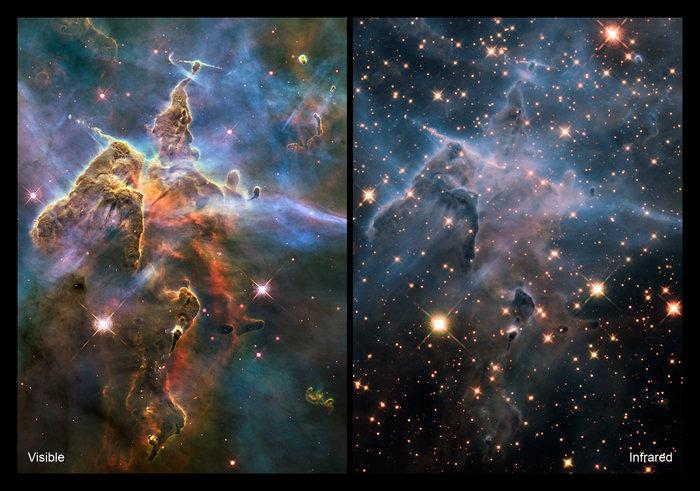what will the webb telescope be able to see
What blazon of light do the telescopes see?
Hubble | JWST |
| Visible and ultraviolet Hubble's main focus is on visible and ultraviolet light. Its instruments can detect a small portion of the infrared spectrum from 0.viii to 2.5 microns, just not to the extent that James Webb can. Instead it focuses its unique ultraviolet (0.1 to 0.iv micron) capabilities on work that cannot be washed from the ground and its visible (0.four to 0.8 micron) lite instruments on producing the loftier resolution images nosotros are nearly familiar with | Reddish and infrared JWST has been designed to focus on the infrared role of the spectrum from 0.half-dozen (red light) to 28 microns (infrared). This means it won't be able to see in ultraviolet light like Hubble, but will be able to focus on infrared bright objects like extremely afar galaxies |
Light travels in a range of frequencies along the electromagnetic spectrum. Our optics have evolved to discover the band of the spectrum which is known as 'visible light', which is unsurprising given that our atmosphere blocks out many of the other wavelengths.
Notwithstanding, there are many other forms of light we cannot see, both inside and exterior our temper.

Infrared lite has a longer wavelength and can pass through objects in infinite that visible calorie-free is blocked by, such as gas and dust. This is why images taken using telescopes which detect infrared frequencies tin can selection out objects beyond these clouds, and appear clearer than those taken using other telescopes.
So is the James Webb Space Telescope replacing the Hubble Space Telescope?
Because JWST doesn't comprehend the same types of light that Hubble is capable of, it isn't truly 'replacing' the same capabilities that Hubble has.
However, while nosotros will lose out on the ability to see in ultraviolet calorie-free in the same fashion that Hubble did, by expanding the range of wavelengths out to infrared lite, JWST will provide access to a function of the spectrum that Hubble never had.
How large are the Hubble and James Webb Infinite Telescopes?
Hubble | James Webb |
| Hubble is 13.ii metres (43.5 ft.) long and its maximum diameter is iv.2 metres (14 ft.) It is about the size of a large truck. Hubble's aperture (the part capable of receiving lite) is 2.four metres across | JWST sunshield is about 22 metres by 12 metres (69.v ft x 46.5 ft). It's about half as big every bit a 737 aircraft. The sunshield is about the size of a tennis court. JWST's aperture is vi.5 metres beyond |
JWST volition have a vast sunshield used to help keep the telescope cool. This is important for all space telescopes but is particularly true for infrared telescopes like JWST every bit 'warm' objects radiate lots of infrared low-cal.
If the telescope itself isn't kept absurd, then the telescope risks blinding itself to the low-cal of whatever object it is attempting to observe.
The principal improvement here though is the telescope aperture.
This is effectively the size of the hole at the terminate of the telescope, or, in the case of telescopes similar these, the size of the mirror that is used to collect the lite. It's the equivalent of the educatee at the centre of our heart, the dark 'hole' that lets in low-cal.
The larger the aperture, the more low-cal the telescope can get together in i go so the fainter an object it tin run across.
Hubble, with its 2.iv metre aperture, can see objects at least 60,000 times fainter than the man eye (which is then profoundly extended by using cameras to take long exposure photographs).
With a mirror almost three times wider, JWST will be able to encounter objects almost nine times fainter than Hubble, allowing usa to peer even further into space.
What are the distances between the telescopes and Earth?
Hubble | JWST |
| The Hubble Infinite Telescope orbits effectually the Earth at an altitude of ~570km | JWST will not really orbit the Earth. Instead it will sit down at the Globe-Sun L2 Lagrange point. This indicate is effectually 1.5 meg kilometres further away from the Sun than the Earth is |
Space-based telescopes take a huge advantage over ground-based ones. By being higher up the atmosphere they don't accept to peer through the shifting air to see into deep space, granting them a clearer view than about footing-based telescopes can achieve. They are also unaffected by the weather, which can be a big problem for astronomers.
Still, being in infinite makes fixing things that go wrong considerably more difficult. Hubble famously had a minor flaw in its mirror upon launch that required a mission into space to fix.
JWST will have no such rescue. At 1.5 million kilometres away, far farther than any human has always travelled, if something goes wrong it won't be possible to head into space and fix information technology.
It is existence placed in such a remote place for several reasons. It keeps the telescope far from the reflected radiation of the Earth, one of many choices designed to keep this highly sensitive telescope cool. It volition also be in a identify where the gravity of the Sun and Earth piece of work together, making information technology easier to keep the satellite in place.
How far back in fourth dimension tin JWST see?
The further away an object is, the further dorsum in time nosotros are looking. This is considering of the fourth dimension it takes calorie-free to travel from the object to us.
With JWST's larger mirror, it will be able to encounter most the whole manner back to the beginning of the Universe, effectually xiii.7 billion years ago.
With its ability to view the Universe in longer wavelength infrared light, JWST volition be capable of seeing some of the most afar galaxies in our Universe, certainly with more ease than than the visible/ultraviolet low-cal view of Hubble.
This is because calorie-free from distant objects is stretched out past the expansion of our Universe - an consequence known every bit redshift - pushing the light out of the visible range and into infrared.
Why has JWST been delayed so long?
Space projects oftentimes have longer than expected, but JWST has been more unlucky than nigh.
It was originally planned to be launched in 2007, but a major redesign, escalating costs and delays led to it being pushed dorsum to around 2018. However, the testing period from 2016 onwards also suffered from long delays, and a further delay was imparted by the global pandemic of 2020.
The launch had been scheduled for eighteen December 2021, just this engagement was pushed dorsum post-obit an 'incident' during launch preparations.
The telescope finally launched on Christmas Day 2021 at 12.20pm GMT (seven.20am EST). Over the next six months, the telescope will undergo a serial of complex deployment operations, including the unfurling of its huge sunshield. Before long nevertheless, it will be set up to deliver its first images and brainstorm a new era in astronomy.
Watch the successful launch back via the NASA live stream below.
Source: https://www.rmg.co.uk/stories/topics/james-webb-space-telescope-vs-hubble-space-telescope

0 Response to "what will the webb telescope be able to see"
Post a Comment